-
Conservation Learning Exchange Highlights Climate, Energy, Population, Poverty
›October 15, 2008 // By Rachel WeisshaarThe Nature Conservancy’s first Conservation Learning Exchange, or ConEx, concludes tomorrow in Vancouver, Canada. It focuses on six themes: climate change and energy; poverty, population growth, and consumerism; ecosystem services; science and technology; working with others; and values and society. You can read more about the goings-on on the ConEx blogs. A sampling from today: “People, poverty and diversity are major themes running throughout this conference and the underlying buzz from the ballrooms to the bars is mission drift. In the sessions I’ve attended, over and over I hear that the Conservancy needs to bring people, of all races, religion and socio-economic backgrounds into our work. Conservation is not just about biodiversity, it is also about human diversity.” -
The Security Implications of Societies’ Demographic Growing Pains
› In their provocative article in The National Interest entitled “The Battle of the (Youth) Bulge” (subscription required), Neil Howe and Richard Jackson take a critical look at the limits of the “youth bulge hypothesis,” which posits that a large and growing proportion of young adults puts societies at greater risk for political instability and civil conflict. The authors’ bigger target in this article is an assumption they perceive as widespread in the security community: that ongoing decline in youth bulges will necessarily produce what the authors dub a “demographic peace.” Howe and Jackson argue that such an expectation is overblown, and that’s clearly the case: Researchers, including myself, describe the effects of a declining youth bulge in terms of lowered risk of instability or conflict (see articles in ECSP Report 10 and ECSP Report 12). Its effects have never been proven absolute or inalterable.
In their provocative article in The National Interest entitled “The Battle of the (Youth) Bulge” (subscription required), Neil Howe and Richard Jackson take a critical look at the limits of the “youth bulge hypothesis,” which posits that a large and growing proportion of young adults puts societies at greater risk for political instability and civil conflict. The authors’ bigger target in this article is an assumption they perceive as widespread in the security community: that ongoing decline in youth bulges will necessarily produce what the authors dub a “demographic peace.” Howe and Jackson argue that such an expectation is overblown, and that’s clearly the case: Researchers, including myself, describe the effects of a declining youth bulge in terms of lowered risk of instability or conflict (see articles in ECSP Report 10 and ECSP Report 12). Its effects have never been proven absolute or inalterable.
For me, Howe and Jackson’s strongest points lie in their identification of four complications that can arise at various points during the demographic transition:- Unsynchronized fertility decline among politically competitive ethnic groups, leading to shifts in ethnic composition;
- Possible instabilities arising from a secondary youth bulge (an echo bulge), created as the previous generation’s bulge passes through its prime childbearing years (see figure);
- Questions about whether fertility can decline “too fast”; and
- The implications of continuous flows of foreign migrants into low-fertility countries—in particular, European countries today.
Some of Howe and Jackson’s other points seem muddled and inconsistent with quantitative studies, however. They cite researchers who argue that the mid-stages of economic development are the most threatening to security, and then link this to the demographic transition by declaring that “economic development…tend[s] to closely track demographic transition in each country.” This is mistaken: An extensive body of research informs demographers that economic development and fertility decline have been only weakly linked, even during the European fertility decline. While in several countries (including Brazil, Mexico, and South Africa) fertility declined abreast of rising per capita income, none of the East Asian “tigers” escaped the World Bank’s low-income country status until fertility dropped to near 3 children per woman, even though this measure had been declining steadily for years.
Nor can Howe and Jackson validate their assertion that having one of the middle structures is riskier than having one of the younger structures. Studies using the Uppsala Conflict Database’s record of minor and major conflicts show that, from 1970-1999, the very youngest countries (median age less than 18) and the middle group (median age 18-25) both experienced elevated risks of the emergence of a civil conflict —and both have large youth bulges. As Leahy and colleagues have shown, the youngest group was at greatest risk.
However, there is a way to salvage Howe and Jackson’s point. When infant mortality declines rapidly in the absence of fertility decline, age structures actually grow younger—in other words, some aspects of development push countries back into the youngest, most vulnerable category. If this is what the authors mean, they could have been clearer.
The authors go on to contend that neo-authoritarian regimes are likely to crop up among late-transition age structures. Here Howe and Jackson cede demography too much power over a state’s destiny. If one considers Deng Xiaoping the architect of China’s neo-authoritarian state, Lee Kwan Yew Singapore’s, Ali Khamenei Iran’s, and Hugo Chávez Venezuela’s, then this thesis has little empirical support. None of these regimes were established during the latter part of the demographic transition. Deng, Lee, and Ali Khamenei actually hastened fertility decline from high levels. I will, however, grant that Deng and Lee grew powerful as their countries’ age structures matured, and as that maturity promoted economic growth and reduced political tensions.
Overall, I’m much more positive than Howe and Jackson. I believe that parts of the world will, indeed, be left more politically stable and more democratic when very young age structures mature. Look at much of East Asia. Few veterans of conflicts in that region would have expected that, in 2008, most of its countries would be listed as vacation spots. I find it hard to believe, as Howe and Jackson do, that the most advanced phases of the demographic transition—a period yet to come—pose the greatest global security threats. Of course, I’m guessing…and so are they.
Richard Cincotta is the consulting demographer for the Long-Range Analysis Unit of the National Intelligence Council.
Figure: Iran’s 2005 youth bulge could give rise to an echo bulge in 2025. Courtesy of Richard Cincotta. -
Environment, Population in the 2008 National Defense Strategy
›The 2008 National Defense Strategy (NDS), released by the U.S. Department of Defense (DoD) earlier this summer, delivers the expected, but also throws in a few surprises. The NDS reflects traditional concerns over terrorism, rogue states, and the rise of China, but also gives a more prominent role to the connections among people, their environment, and national security. Both natural disasters and growing competition for resources are listed alongside terrorism as some of the main challenges facing the United States.
This NDS is groundbreaking in that it recognizes the security risks posed by both population growth and deficit—due to aging, shrinking, or disease—the role of climate pressures, and the connections between population and the environment. In the wake of the Intergovernmental Panel on Climate Change (IPCC) reports on climate change and the CNA study on climate change and security, Congress mandated that the NDS include language on climate change. The document is required to include guidance for military planners to assess the risks of projected climate change on the armed forces (see Section 931 of the FY08 National Defense Authorization Act). The document also recognizes the need to address the “root causes of turmoil”—which could be interpreted as underlying population-environment connections, although the authors provide no specifics. One missed opportunity in the NDS is the chance to explicitly connect ungoverned areas in failed or weak states with population-environment issues.
What really stands out about this NDS is how the authors characterize the future security environment: “Over the next twenty years physical pressures—population, resource, energy, climatic and environmental—could combine with rapid social, cultural, technological and geopolitical change to create greater uncertainty,” they write. The challenge, according to DoD, is the uncertainty of how these trends and the interactions among them will play out. DoD is concerned with environmental security issues insofar as they shift the power of states and pose risks, but it is unclear from the NDS what precisely those risks are, as the authors never explicitly identify them. Instead, they emphasize flexibility in preparing to meet a range of possible challenges.
The environmental security language in this NDS grew out of several years of work within the Department, primarily in the Office of Policy Planning under the Office of the Under Secretary for Defense. The “Shocks and Trends” project carried out by Policy Planning involved several years of study on individual trends, such as population, energy, and environment, as well as a series of workshops and exercises outlining possible “shocks.” The impact of this work on the NDS is clear. For example, the NDS says “we must take account of the implications of demographic trends, particularly population growth in much of the developing world and the population deficit in much of the developed world.”
Finally, although the NDS mentions the goal of reducing fuel demand and the need to “assist wider U.S. Government energy security and environmental objectives,” its main energy concern seems to be securing access to energy resources, perhaps with military involvement. Is this another missed opportunity to bring in environmental concerns, or is it more appropriate for DoD to stick to straight energy security? The NDS seems to have taken a politically safe route: recognizing energy security as a problem and suggesting both the need for the Department to actively protect energy resources (especially petroleum) while also being open to broader ways to achieve energy independence.
According to the NDS, DoD should continue studying how the trends outlined above affect national security and should use trend considerations in decisions about equipment and capabilities; alliances and partnerships; and relationships with other nations. As the foundational document from which almost all other DoD guidance documents and programs are derived, the NDS is highly significant. If the new administration continues to build off of the current NDS instead of starting anew, we can expect environmental security to play a more central role in national defense planning. If not, environmental security could again take a back seat to other national defense issues, as it has done so often in the past.
Jennifer Dabbs Sciubba is the Mellon Environmental Fellow in the Department of International Studies at Rhodes College. She worked in the Office of Policy Planning as a demography consultant during the preparations for the 2008 NDS and continues to be affiliated with the office. The views expressed in this article are those of the author and do not reflect the official policy or position of the Department of Defense or the U.S. government.
For more information, see Sciubba’s article “Population in Defense Policy Planning” in ECSP Report 13. -
PODCAST – Sharing the Forest: Protecting Gorillas and Helping Families in Uganda
›October 9, 2008 // By Wilson Center Staff<href=”https://d3i11i4ld2ygwb.cloudfront.net/uploads/2012/07/Kalema-Zikusoka1.png”>
 Gladys Kalema-Zikusoka is founder and CEO of Conservation Through Public Health (CTPH), an NGO that seeks to save the endangered mountain gorillas of Uganda’s Bwindi Impenetrable National Park and improve the health and livelihoods of people living on the outskirts of Bwindi. Close proximity of humans and gorillas has resulted in the transfer of a number of diseases, including tuberculosis and scabies. In this podcast, Kalema-Zikusoka describes CTPH’s success providing integrated health services, educating people about family planning methods, reducing human–wildlife conflict, and improving local livelihoods. In “Sharing the Forest: Protecting Gorillas and Helping Families in Uganda,” the latest issue in ECSP’s Focus series, Kalema-Zikusoka and coauthor Lynne Gaffikan write that “members of these communities have the potential to serve as model stewards of the country’s natural resource wealth”–if their health needs are met and livelihoods improved. Kalema-Zikusoka recently spoke at the Wilson Center on human, animal, and ecosystem health and population-health-environment lessons from East Africa.
Gladys Kalema-Zikusoka is founder and CEO of Conservation Through Public Health (CTPH), an NGO that seeks to save the endangered mountain gorillas of Uganda’s Bwindi Impenetrable National Park and improve the health and livelihoods of people living on the outskirts of Bwindi. Close proximity of humans and gorillas has resulted in the transfer of a number of diseases, including tuberculosis and scabies. In this podcast, Kalema-Zikusoka describes CTPH’s success providing integrated health services, educating people about family planning methods, reducing human–wildlife conflict, and improving local livelihoods. In “Sharing the Forest: Protecting Gorillas and Helping Families in Uganda,” the latest issue in ECSP’s Focus series, Kalema-Zikusoka and coauthor Lynne Gaffikan write that “members of these communities have the potential to serve as model stewards of the country’s natural resource wealth”–if their health needs are met and livelihoods improved. Kalema-Zikusoka recently spoke at the Wilson Center on human, animal, and ecosystem health and population-health-environment lessons from East Africa.
Sharing the Forest-Protecting Gorillas and Helping Families in Uganda: Download
Photo: Gladys Kalema-Zikusoka. Courtesy of Heidi Fancher and the Woodrow Wilson Center. -
A Roadmap for Future U.S. International Water Policy
› When I tell people I have been working on a report about U.S. international water policy, they usually respond with the same sardonic question: “The United States has an international water policy?” The answer, of course, is complicated. Yes, we have localized approaches to water challenges in parts of the developing world, and we have more than 15 government agencies with capacities to address water and sanitation issues abroad. And yes, the State Department and the U.S. Agency for International Development published a joint strategic framework this year for action on water issues in the developing world.
When I tell people I have been working on a report about U.S. international water policy, they usually respond with the same sardonic question: “The United States has an international water policy?” The answer, of course, is complicated. Yes, we have localized approaches to water challenges in parts of the developing world, and we have more than 15 government agencies with capacities to address water and sanitation issues abroad. And yes, the State Department and the U.S. Agency for International Development published a joint strategic framework this year for action on water issues in the developing world.
However, the U.S. government (USG) does not yet have an overarching strategy to guide our water programs abroad and maximize synergies among (and within) agencies. Furthermore, the 2005 Senator Paul Simon Water for the Poor Act—which calls for increased water and sanitation assistance to developing countries—has yet to be funded and implemented in a fashion that satisfies lawmakers. In fact, just last week, legislation was introduced in both the House and the Senate to enhance the capacity of the USG to fully implement the Water for the Poor Act.
Why has implementation been so slow? An underlying problem is that water still has no institutional home in the USG, unlike other resources like agriculture and energy, which have entire departments devoted to them. In the current system, interagency water coordination falls on a small, under-resourced (yet incredibly talented and dedicated) team in the State Department comprised of individuals who must juggle competing priorities under the broad portfolio of Oceans, Environment, and Science. In part, it is water’s institutional homelessness that hinders interagency collaboration, as mandates and funding for addressing water issues are not always clearly delineated.
So, what should be done? For the last year and a half, the Center for Strategic and International Studies’ (CSIS) Global Strategy Institute has consulted with policy experts, advocates, scientists, and practitioners to answer this million-dollar question. In our report, Global Water Futures: A Roadmap for Future U.S. Policy, we conclude that if we are serious about achieving a range of our strategic national interests, water must be elevated as a priority in U.S. foreign policy. Water is paramount to human health, agricultural and energy production, education, economic development, post-conflict stabilization, and more—therefore, our government’s organizational structure and the resources it commits to water should reflect the strategic importance of this resource.
Studies’ (CSIS) Global Strategy Institute has consulted with policy experts, advocates, scientists, and practitioners to answer this million-dollar question. In our report, Global Water Futures: A Roadmap for Future U.S. Policy, we conclude that if we are serious about achieving a range of our strategic national interests, water must be elevated as a priority in U.S. foreign policy. Water is paramount to human health, agricultural and energy production, education, economic development, post-conflict stabilization, and more—therefore, our government’s organizational structure and the resources it commits to water should reflect the strategic importance of this resource.
We propose the creation of a new bureau or “one-stop shop” for water policy in the State Department to lead in strategic planning, implementation, and evaluation of international water programs; mobilize resources in support of water programming overseas; provide outreach to Congress and important stakeholders; and serve as a research and information clearinghouse. This would require significant support from the highest levels of government, increased funding, and greater collaboration with the private and independent sectors.
The current economic crisis means we are likely to face even greater competition for scarce foreign aid resources. But I would argue—paraphrasing Congressman Earl Blumenauer at our report rollout—that relatively little funding toward water and sanitation can have a significant impact around the world. As we tighten our belts during this period of financial instability, it is even more important that we invest in cross-cutting issues that yield the highest returns across defense, development, and diplomacy. Water is an excellent place to start.
Rachel Posner is a research associate at the Center for Strategic and International Studies’ Global Strategy Institute.
Photo: Environmental Change and Security Program Director Geoff Dabelko and Congressman Earl Blumenauer (D-OR) at the launch of Global Water Futures: A Roadmap for Future U.S. Policy. Courtesy of CSIS. -
Dispatches From the World Conservation Congress: Jason Bremner on Healthy Environments, Healthy People
›October 8, 2008 // By Jason Bremner I’ve been busy the last several days attending the “Healthy Environments—Healthy People” stream of the World Conservation Congress. While there has been much talk about the connections between environmental services and people’s livelihoods and allusions to how this links with human health, I’ve been surprised by the scarcity of actual documented linkages between conservation strategies and human health.
I’ve been busy the last several days attending the “Healthy Environments—Healthy People” stream of the World Conservation Congress. While there has been much talk about the connections between environmental services and people’s livelihoods and allusions to how this links with human health, I’ve been surprised by the scarcity of actual documented linkages between conservation strategies and human health.
This conundrum got me thinking about why there aren’t more people trying to actually evaluate impacts on human health. Do environmentalists simply lack the tools and expertise to evaluate human-health impacts? Are human-health benefits too hard to measure? Or does conservation not really have any human-health benefits? No, no, and no again are my answers to these questions.
I think the real problem is that “healthier people” is really just a good selling-point for conservation rather than a true objective of most conservation institutions. In other words, arguing that environmental health promotes human health is a good way for conservation organizations to expand their constituency.
Am I a jaded conference participant who has simply attended one too many sessions? I don’t think so, based on a meeting I attended last week of the EuroNGOs, a network of European organizations advocating for sexual and reproductive health. The topic of this year’s EuroNGOs meeting? The interface between population, environment, and poverty alleviation. Was this really a group of population and health organizations interested in adding an environmental dimension to their work or interested in the environmental benefits of their work? No—the real purpose was to increase funding for sexual and reproductive health by discussing the links and benefits related to environmental conservation and poverty alleviation. So these are different communities coming together for a common goal: to increase the funding for their particular missions.
Does this mean, however, that it is wrong to advocate for conservation interventions based on health benefits or wrong to advocate for health interventions based on environmental benefits? I don’t think so. I just think we need to do a better job of building bridges across communities. It would have been wonderful to have a few environmental organizations at the EuroNGOs meeting and a few more health organizations at the World Conservation Congress. Perhaps then we would do a better job evaluating the cross-sectoral benefits of our health and environment work.
Jason Bremner is program director for population, health, and environment at the Population Reference Bureau.
Photo courtesy of Geoff Dabelko. -
Dispatches From the World Conservation Congress: Geoff Dabelko on Environment, Security
›October 7, 2008 // By Geoffrey D. Dabelko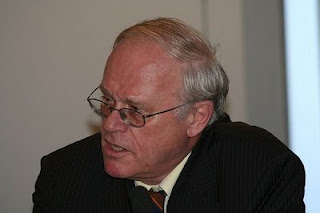 “The input of the security sector is indispensable for finding the balance” between mitigation and adaptation efforts to combat climate change, said Wouter Veening, co-founder and chairman of the Institute for Environmental Security, based in The Hague, Netherlands. Veening was the first among many speakers in a linked set of panels entitled “Environment and Security Challenges for Change” here at the World Conservation Congress in Barcelona.
“The input of the security sector is indispensable for finding the balance” between mitigation and adaptation efforts to combat climate change, said Wouter Veening, co-founder and chairman of the Institute for Environmental Security, based in The Hague, Netherlands. Veening was the first among many speakers in a linked set of panels entitled “Environment and Security Challenges for Change” here at the World Conservation Congress in Barcelona. -
Dispatches From the World Conservation Congress: John Pielemeier
›October 7, 2008 // By John Pielemeier This has been quite an interesting first day at the World Conservation Congress Forum in Barcelona. Since I’m not a conservation expert (I’m here to participate on a panel on population, health, and environment programs), I’m enjoying the opportunity to view the conference a bit like an anthropologist. Here are a few observations from Day One:
This has been quite an interesting first day at the World Conservation Congress Forum in Barcelona. Since I’m not a conservation expert (I’m here to participate on a panel on population, health, and environment programs), I’m enjoying the opportunity to view the conference a bit like an anthropologist. Here are a few observations from Day One:
The conference has an interesting structure. In an effort to provide some organization for such a large conference (8,000 participants and 800 panels/events) there are three main “streams,” including “Healthy Environments, Healthy People”—the reason our panel was accepted—along with “A New Climate for Change” and “Safeguarding the Diversity of Life.” The participants are also encouraged to join one of 12 “journeys” (e.g., “Forests Journey,” “Species Journey”) to help bring them together for smaller meetings and social events. I found that I couldn’t get into the Forests Happy Hour this evening because I hadn’t signed up for the “Journey.” Some incentives do matter—if only I had known!
Despite the “healthy” headlines, very few panels discuss the relationships between human or animal health and the environment, and there are no health-related “journeys.” The one bright spot regarding interdisciplinary linkages thus far was an announcement by the Australian national parks director that he would host a major “Healthy Parks, Healthy People” meeting in 2010 where 50 percent of the attendees would be health professionals.
Some sessions are held in the Knowledge Café, a large room where folks join one of 12 round conversation tables based on special topics. The United Nations has funded a special program, called “Poble,” which has brought a significant number of indigenous people, in tribal headgear and colorful traditional dress, to the conference. The Poble meetings are in a large room with a low stage and no chairs; attendees sit or lie on the floor while listening to the presentations of their colleagues. The room has been full every time I have peered in.
Attendance seems to vary considerably among sessions. A Knowledge Café roundtable meeting on climate change attracted mid-career pros from the Global Environment Facility, the European Union, the United Nations, and scientific organizations, and the level of the unmoderated discussion was extremely high. Participants were well-informed about the issues facing the international community over the next few months, and were also familiar with the latest ideas regarding how to address climate change. On the other hand, a panel session on accountability in conservation programs and among environmental NGOs attracted only nine attendees who listened to four (good!) speakers. After tomorrow’s sessions, I’ll have an even better sense of which themes are attracting the attention of the conservation professionals here.
John Pielemeier is an international development consultant. During his 22-year career at the U.S. Agency for International Development (USAID), he served as USAID mission director in Brazil, USAID/Washington office director for South Asia, and as a special assistant in the office of the USAID administrator.
Photo courtesy of Heidi Fancher and the Woodrow Wilson Center.
Showing posts from category *Main.


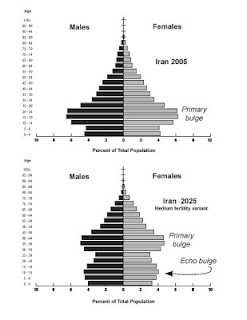 In their provocative article in The National Interest entitled “
In their provocative article in The National Interest entitled “ Gladys Kalema-Zikusoka is founder and CEO of
Gladys Kalema-Zikusoka is founder and CEO of 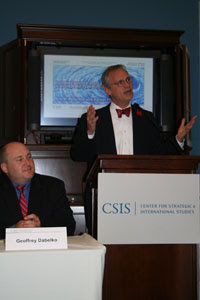 When I tell people I have been working on a report about U.S. international water policy, they usually respond with the same sardonic question: “The United States has an international water policy?” The answer, of course, is complicated. Yes, we have localized approaches to water challenges in parts of the developing world, and we have
When I tell people I have been working on a report about U.S. international water policy, they usually respond with the same sardonic question: “The United States has an international water policy?” The answer, of course, is complicated. Yes, we have localized approaches to water challenges in parts of the developing world, and we have 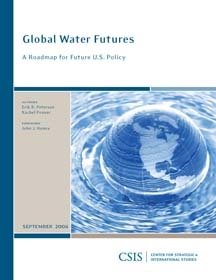 Studies’ (CSIS)
Studies’ (CSIS)  I’ve been busy the last several days attending the “Healthy Environments—Healthy People” stream of the
I’ve been busy the last several days attending the “Healthy Environments—Healthy People” stream of the 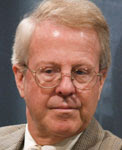 This has been quite an interesting first day at the
This has been quite an interesting first day at the 

